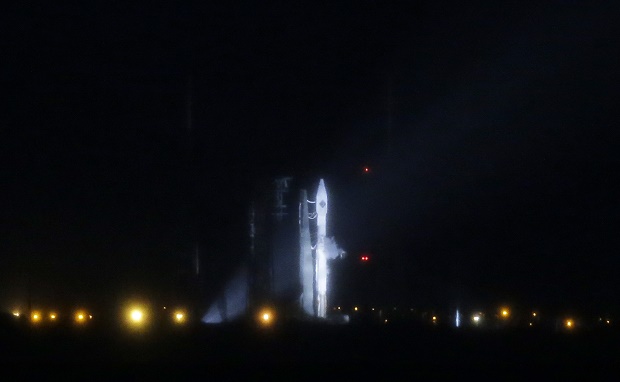
A United Launch Alliance Atlas V rocket stands ready shortly before a launch attempt was scrubbed due to poor weather conditions on launch complex 41at the Cape Canaveral Air Force Station, Thursday, Dec. 3, 2015, in Cape Canaveral, Fla. Another launch attempt is set for Friday. AP
CAPE CANAVERAL, Florida — Wet and cloudy weather prevented NASA from resuming commercial space station deliveries Thursday.
The space agency was looking to get back on track with the first US shipment to the International Space station in nearly eight months, but thick clouds and rain prevented an unmanned Atlas rocket from lifting off at dusk with 7,400 pounds of critical supplies.
With 14 minutes left, and no better weather in sight, launch director Bill Cullen halted the countdown, praising his team for “great discipline.”
The next launch opportunity is Friday, but the forecast isn’t much better.
Two of the last four commercial supply runs, contracted by NASA, have failed. The first launch accident occurred in Virginia in October 2014, the second at Cape Canaveral in June. Add in a lost Russian cargo ship in April, and the cupboards in orbit have suffered.
READ: Russia loses control of unmanned spacecraft | Russian supply ship docks at space station
NASA’s space station program manager, Kirk Shireman, said earlier this week that without another delivery, the six astronauts’ food would run out in April. A Russian supply run planned for later this month, if successful, would buy more time. Even with the resumption of American shipments, it will take a year for the 250-mile-high pantry to be as full as it was before the string of accidents, he told reporters.
Orbital ATK is using another company’s rocket to launch this shipment because its own rocket, the Antares, remains grounded. The last time Orbital launched, its rocket exploded seconds after liftoff from Wallops Island, Virginia, destroying the Cygnus cargo carrier and damaging the pad.
The other private company hired by NASA to deliver supplies, SpaceX, also remains stuck on Earth, at least until next month. The company’s Falcon rocket ended up in the Atlantic at the end of June, along with a new docking port and everything else destined for the space station. It was the company’s first failure since making the first commercial space station shipment in 2012.
READ: US space station delivery on tap after 8-month stoppage
The United Launch Alliance’s Atlas V — a mighty successor of the rocket used to put John Glenn in orbit in 1962 — has never been used before on a space station mission. A second Atlas will make a supply run for Orbital in March, before the Antares is back in business.
The Antares carried out three station shipments before trouble with the old Russian-built rocket engines doomed the fourth flight. SpaceX stumbled on its eighth trip.
Orbital’s newest Cygnus capsule — named after the swan constellation — holds food, clothes, Christmas presents, spacewalking gear, high-pressure nitrogen and oxygen tanks for the air supply, and science experiments.
The station-bound research includes mini satellites to be released in the weeks ahead by the astronauts. One was designed, tested and built by students at St. Thomas More Cathedral School in Arlington, Virginia — the first such effort by elementary-age children.
The 4-inch cube houses a camera for Earth picture-taking, as well as a crucifix and religious medal blessed by Pope Francis.
Also accompanying the flight: “Lots of prayers,” said Principal Eleanor McCormack.